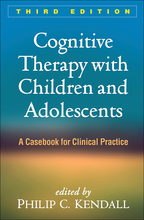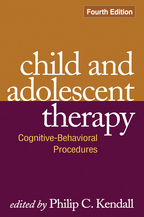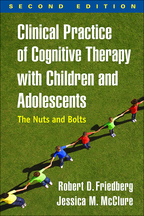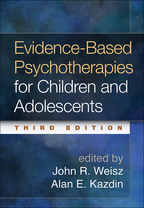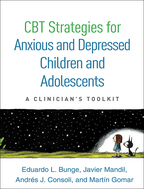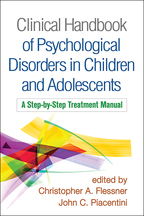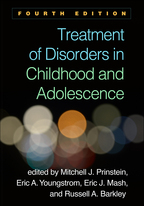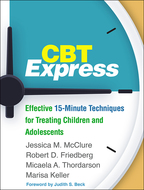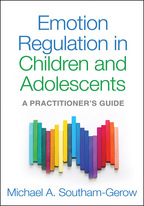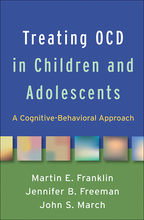Cognitive Therapy with Children and Adolescents
Third Edition
A Casebook for Clinical Practice
Edited by Philip C. Kendall
HardcoverPaperbacke-bookprint + e-book
Hardcover
orderOctober 25, 2017
ISBN 9781462532162
Price: $74.00 340 Pages
Size: 6" x 9"
Paperback
orderOctober 26, 2017
ISBN 9781462528233
Price: $49.00340 Pages
Size: 6" x 9"
“A welcome addition to the growing body of clinically relevant, data-based literature....The editors fulfill their goals admirably, providing a wealth of scientific knowledge and integrating it with clinical experience. They succeed in covering a broad range of issues in a clear and understandable manner.”

—Child and Family Behavior Therapy (on the second edition)
“Each chapter illustrates how skilled therapists can flexibly and creatively adapt standard protocols to a youth's developmental age so that interventions are engaging and effective….Clinicians new to cognitive-behavior therapy for youth will find the book a useful introduction to the adaptability and flexibility of cognitive-behavioral formulation and treatment of a wide variety of problems typically seen in routine clinical practice.”

—Cognitive Behavioral Therapy Book Reviews (on the second edition)
“Incredibly, this third edition surpasses the first two in terms of thoroughness, timeliness, ease of understanding, and mastery of the relevant clinical material. It continues to be the go-to volume for clinicians, investigators, and trainees interested in moving the dial with respect to efficacy and effectiveness for the major mental health conditions affecting youth. Five stars!”

—Stephen P. Hinshaw, PhD, Department of Psychology, University of California, Berkeley; Department of Psychiatry, University of California, San Francisco
“In the third edition, Kendall has curated a collection of clinically rich, informative, and engaging chapters covering a wide variety of problems. This highly pragmatic casebook showcases innovative thinking about CBT for youth. Readers will appreciate both the depth offered by many of the leading clinical researchers and the breadth of topics covered. It is an encyclopedia of clinical wisdom that offers something for everyone.”

—Bruce F. Chorpita, PhD, Department of Psychology, University of California, Los Angeles; President, PracticeWise
“The third edition builds well on previous editions, and nicely blends theory and practice in chapters from world-leading authorities. It is suffused with practical materials for treatment planning and therapist–client dialogues to help the reader fully understand how to implement the treatments. A significant advance for this edition is its emphasis on transdiagnostic aspects of case conceptualization and treatment. Trainees and experts alike will find value in this well-planned, well-implemented text.”

—Keith S. Dobson, PhD, Department of Psychology, University of Calgary, Canada
“Kendall has produced an outstanding volume for clinicians who are passionate about empirically supported treatments for children and adolescents. This state-of-the-art work helps clinicians to flexibly adapt treatment protocols for a range of disorders, with practical examples and rich descriptive cases. It also provides a solid review of theoretical foundations and up-to-date research findings. A 'must-have' text.”

—Jennifer L. Hudson, PhD, Director, Centre for Emotional Health, Department of Psychology, Macquarie University, Australia
“A welcome update of a seminal work, edited and written by international experts in CBT with children and youth. The strength of the book is its focus on clinical practice—each chapter provides ample material about both the process and content of developmentally and culturally sensitive interventions, brought to life through detailed case examples. Common themes include creative uses of nonverbal methods, parent involvement, the use of behavioral techniques, and how to adapt cognitive work to the developmental level of the child. This book is essential reading for any practicing child mental health professional.”

—Paul Stallard, PhD, Professor of Child and Family Mental Health, University of Bath, United Kingdom
—Child and Family Behavior Therapy (on the second edition)
“Each chapter illustrates how skilled therapists can flexibly and creatively adapt standard protocols to a youth's developmental age so that interventions are engaging and effective….Clinicians new to cognitive-behavior therapy for youth will find the book a useful introduction to the adaptability and flexibility of cognitive-behavioral formulation and treatment of a wide variety of problems typically seen in routine clinical practice.”
—Cognitive Behavioral Therapy Book Reviews (on the second edition)
“Incredibly, this third edition surpasses the first two in terms of thoroughness, timeliness, ease of understanding, and mastery of the relevant clinical material. It continues to be the go-to volume for clinicians, investigators, and trainees interested in moving the dial with respect to efficacy and effectiveness for the major mental health conditions affecting youth. Five stars!”
—Stephen P. Hinshaw, PhD, Department of Psychology, University of California, Berkeley; Department of Psychiatry, University of California, San Francisco
“In the third edition, Kendall has curated a collection of clinically rich, informative, and engaging chapters covering a wide variety of problems. This highly pragmatic casebook showcases innovative thinking about CBT for youth. Readers will appreciate both the depth offered by many of the leading clinical researchers and the breadth of topics covered. It is an encyclopedia of clinical wisdom that offers something for everyone.”
—Bruce F. Chorpita, PhD, Department of Psychology, University of California, Los Angeles; President, PracticeWise
“The third edition builds well on previous editions, and nicely blends theory and practice in chapters from world-leading authorities. It is suffused with practical materials for treatment planning and therapist–client dialogues to help the reader fully understand how to implement the treatments. A significant advance for this edition is its emphasis on transdiagnostic aspects of case conceptualization and treatment. Trainees and experts alike will find value in this well-planned, well-implemented text.”
—Keith S. Dobson, PhD, Department of Psychology, University of Calgary, Canada
“Kendall has produced an outstanding volume for clinicians who are passionate about empirically supported treatments for children and adolescents. This state-of-the-art work helps clinicians to flexibly adapt treatment protocols for a range of disorders, with practical examples and rich descriptive cases. It also provides a solid review of theoretical foundations and up-to-date research findings. A 'must-have' text.”
—Jennifer L. Hudson, PhD, Director, Centre for Emotional Health, Department of Psychology, Macquarie University, Australia
“A welcome update of a seminal work, edited and written by international experts in CBT with children and youth. The strength of the book is its focus on clinical practice—each chapter provides ample material about both the process and content of developmentally and culturally sensitive interventions, brought to life through detailed case examples. Common themes include creative uses of nonverbal methods, parent involvement, the use of behavioral techniques, and how to adapt cognitive work to the developmental level of the child. This book is essential reading for any practicing child mental health professional.”
—Paul Stallard, PhD, Professor of Child and Family Mental Health, University of Bath, United Kingdom

